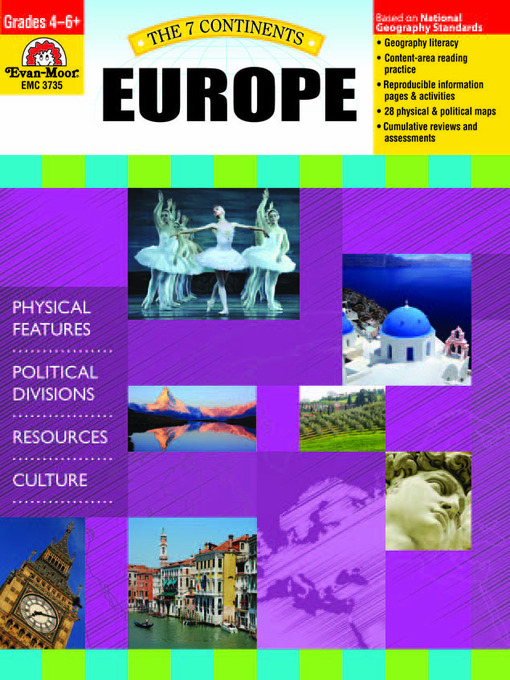Develop geography literacy while learning about the unique characteristics of Europe! The 7 Continents: Europe helps students learn about Europe through engaging reading and writing activities. Five geography units cover the following standards-based topics: Section 1: Europe in the World Introduces students to the location of Europe in the world. Europe's Relative Location Europe's Hemispheres Europe's Absolute Location Using a Projection Map Section 2: Political Divisions of Europe Introduces students to the four regions and 44 countries of Europe. Political Divisions of Europe Population of Europe Countries of Europe Largest Countries by Area Largest Countries by Population Western Europe Eastern Europe Southern Europe Northern Europe Capital Cities of Europe Communism in Europe European Union Section 3: Physical Features of Europe Students learn about the landforms and bodies of water of Europe. Europe's Landscape European Peninsulas European Islands Mountains of Europe Volcanoes of Europe Europe's Forests Northern Tundra Europe's Bodies of Water Seas of Europe Rhine River Norway's Fjords Section 4: Valuable Resources of Europe Students learn about the various natural resources of Europe. Oil Production in Europe Fishing in Europe Grains and Potatoes Olives Wine Production Livestock Europe's Forests Wildlife of Europe Section 5: European Culture Introduces students to the architecture, arts, beliefs, and traditions of Europe. Tourist Attractions Fine Art Music Languages Religions European Cuisine Celebrations
- Everyone Reads: Social Emotional Learning
- Travel Guides
- Spotlight on: Mental Health
- Deaf Culture, Experience, and History
- Autism Awareness
- Employment and Career Resources
- Black Lives Matter - Books for Young People
- Celebrate National Native American Heritage
- Latinx Authors
- Anti-Racist Reading
- Schomburg Center Black Liberation Reading List
- Books to Battle Quarantine Sleep Problems
- Never, Never, Never Give Up
- See all useful topics collections
- eBooks with no wait lists!
- Most popular
- Just Added
- Books in Spanish/Libros en Español
- SciFi Old & New, Contemporary & Classic
- Read-Along Books
- Popular Mysteries
- Try something different
- Why Wait? Always Available Classics
- Comics and Graphic Novels
- Escape into History: Historical fiction
- Manga for Grownups
- eBooks with no wait
- See all ebooks collections
- Always Available Audio
- It's Your Lucky Day! Audiobooks+
- Modern Scholar Audiobooks - NO WAITING!
- Legacy Washington Audio Collection - Listen NOW!
- Most popular
- Just Added
- Spanish/Audiolibros en Español
- Stranger than Fiction
- Try something different
- Family Road Trip Audiobooks
- You can't hit pause on these thrillers
- Best Audiobooks under 3 Hours
- Listen up; now hear this!
- See all audiobooks collections
- Now's Your Chance!
- En español - lo nuestro
- Microhistories - Get down in the weeds with these intriguing titles!
- D-Day, June 6, 1944
- Unreliable Narrators
- Bibliotherapy
- Steampunk
- Dealing with Addiction
- Historical Fiction
- Presidents and Politics
- Laughing all the way to the bank
- Geek Pride
- Stranger than Fiction
- See all eyes and ears collections
